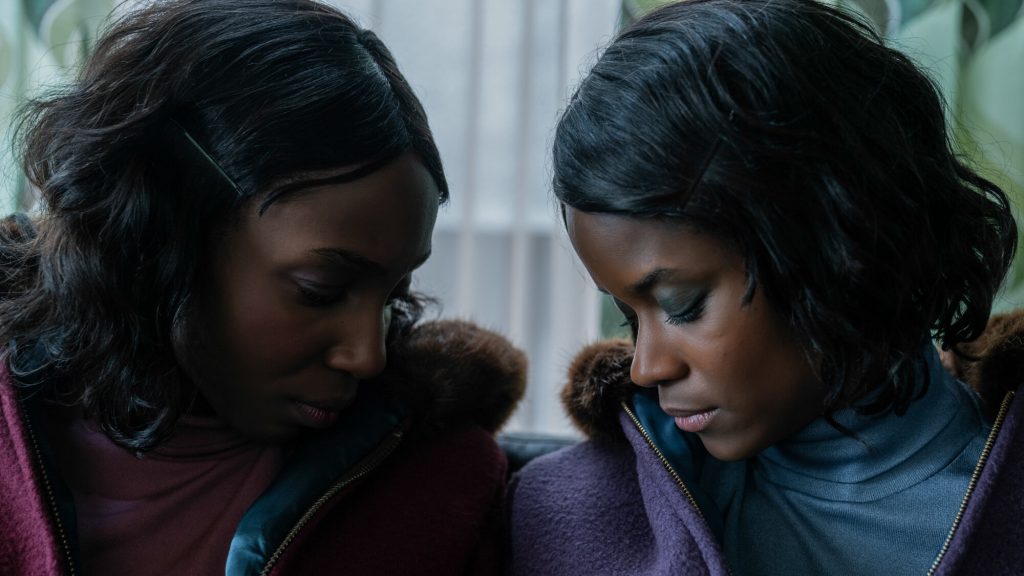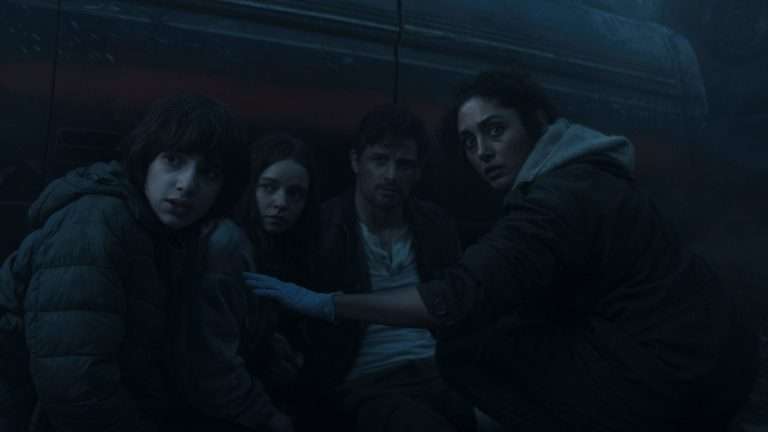The case of the Gibbons sister astounded the media and academics alike for decades. The story originated in Wales. The Gibbons were immigrants from the Caribbean and came to the country at a time of social and racial unrest. Interestingly, the two started to communicate only with each other and not with anyone else after a certain age. Their unbreakable bond became a subject of mass hysteria and pain for the family. Despite their circumstances, the girls were prolific writers and published acclaimed works. Agnieszka Smoczyńska adapts their story in a harrowing manner in ‘The Silent Twins.’ Unlike most conventional biopics, Agnieszka takes a different approach to bringing the sisters’ life on screen.
Like ‘Blonde’ on Netflix, he creates a real, visceral portrayal of the two that is perhaps too intensely true to life. One of the reasons for the film’s cryptic and seemingly inaccessible plot is the use of the sisters’ personal diaries and private notes as inspiration for the events. For those who have seen ‘The Electrical Life of Louis Wain,’ The Silent Twins unfolds like its second half. We see the world through their eyes, highlights, and pitfalls. The surreal element in the storytelling truly stands out as a unique opportunity to witness the inspiraling of their sanity. This ending explainer of ‘The Silent Twins’ tries to answer some of the strange questions about the sisters and not necessarily the plot, as it is mostly nonexistent. Please note that some of it might not be totally accurate, just as in the film, and is not meant to disrespect or degrade the image of the real-life sisters.
The Silent Twins Plot Summary & Movie Synopsis:
Why did the sisters decide not to communicate with anyone else?

Quite interestingly, the answer to the question lies in the details. There is a multitude of factors at play here. Firstly, the twins were ruthlessly bullied and ostracized at school. Their diaries revealed that they were the only black children in the community where they went. Racial tensions were, of course, high at the time, not just in the country but around the globe. Adding to their woes was bullying by older kids, as seen in the film. They were almost in a catatonic state when not together at school, and the haughty ones took advantage of that. We see one of them spitting onto June’s mouth and asking her to swallow it.
Apart from these external forces at school, the sisters also started to create their language in a bid to make their relationship and company exclusive to each other. Although they started with English, they soon changed to another language while communicating. According to records, and as confirmed by the film, they spoke a version of Bajan Creole, a language not native to the region or the family. And the way they said it was a little bit hard to understand. It was almost as if they deliberately tried to isolate themselves from the outer world.
The sisters wrote extensively in their journals in their room, which became their sanctuary. Each entry was not necessarily a personal milestone, but even the most minor things found their way into them. That is where they got all the great ideas for the books they ended up writing.
Why were the sisters sent away from each other?
An attempt was made by counselors and medical professionals to figure out the reason for their indentured conditioning. It was beyond books, and specific experiments were required in a hit-and-trial kind of setup. One of the proposals floated was separating the two and seeing how they reacted. It happened at a very early age, and in the movie, we see a brief period when they went to different boarding schools. But, as we saw, the experiment failed quite miserably. The sisters kept running away from the facilities in acts of defiance. They refused food or doing anything other than lying on their beds and hoping it would reunite them. This segment also answers the questions of how the twins were able to communicate telekinetically to give each other signals and indications.
The answer to the latter does not have too much to do with the film than the research and advances academics have made in their field of study. Most scholars believe that identical twins often have the ability to have a shared experience of the universe in their early ages before their cerebral development. On account of being twins, the sisters developed a very close bond. But for most pairs, that ends after they have reached a certain age. Only in the rarest of rare cases does that lead to something like this. Of course, this isn’t the first example of twins behaving erratically to shut out the outer world. But it does not happen often.
Another fun fact is that this happened to the sisters and even got published in newspapers. A quote from Marjorie Wallace’s book, on which the film is based, reads as follows.
“The girls continued to attend school, although they refused to read or write. In 1974, a medic administering vaccinations at the school noted their impassive behavior and notified a child psychologist. The twins began seeing a succession of therapists who tried unsuccessfully to get them to communicate with others. They were sent to separate boarding schools in an attempt to break their isolation, but the pair became catatonic and entirely withdrawn when parted”.
What were the fleeting animation bits about?
The animation bits were perhaps the most intriguing element of the storytelling. According to the director Agnieszka Smoczyńska, these bits were written up by the sisters in the form of short stories in their personal journals. The first one we see about the two parrots is quite obvious. They wrote about themselves and how they felt like “animals in a zoo” that people come to watch and find amusement in their condition. The Pallensburg tangent, too, plays heavily on the real-life events that happened to them and traumatized them. If you observe closely enough, the story was about Jennifer being given a new heart. That was indeed hope and what June wanted more than anything.
She desperately wanted her sister to survive the disease she contracted, but in the end, she couldn’t. The animations we see in the story do not have relevance to the plot but are an attempt to understand the perspective of the twins. Agnieszka wanted to put the viewer in the sisters’ shoes and make us experience the treatment that was meted out by the world. They were made to feel like second-class citizens and had no empathy from anyone. All they were to the outside world was a science experiment. It comes through strongly in those bits which look great owing to the stop-motion animation technology.
How do June and Jennifer end up in the mental hospital?
The sisters went through a dark phase that changed the course of their lives. Because of their condition and a hormonal urge to pursue boys, they fell for the bad ones. Wayne and his brother introduced the twins to many vices that destroyed their lives. It first started with drugs and alcohol. The first few occasions felt heavenly to the girls, quickly becoming a habit. But the most damaging aspect certainly was that of robberies. Both these boys were low-end criminals doing petty things such as breaking and pickpocketing people. As an act of rebellion, the girls found meaning and purpose in replicating those and joining them on some of their sprees.
In one scene in the film, we see the girls breaking into a store and lighting it up on fire. This was the first time they were caught by the authorities and then taken to court for sentencing. If one looks at penal codes across the globe, the punishment – both fines and imprisonment – are minor. In the case of first-time offenders, judges often let the matters go with community service. But this case was special. The judge called upon an expert amicus curia to navigate the delicate reality of the case. Despite their best attempts, the sisters’ families and counselors could not convince the judge that the sisters were fit for the outside world.
On the expert’s recommendation, they were sent to the mental hospital on a life term. They posed a threat, not just to themselves, but others also if they were allowed to stay outside. Even in the facility, they had to be put into different rooms due to seriously violent episodes of fighting between themselves. The separation once again proved brutal on them, especially June, who was the beta in the relationship.
The Silent Twins Movie Ending, Explained:
How does June reintegrate back into society?
The ending of The Sister Twins is intriguing for many reasons. But it is also somewhat tragic. After the sisters are locked in the mental hospital and separated, June finally starts to open up a bit. She is still under her sister’s influence but shows signs things might be improving. She attempted suicide, and Jennifer’s “intervention” saved her life. Jennifer’s health worsens as the days go by. When Marjorie becomes interested in writing a book about their story, the sisters have mixed feelings about it. She knows she does not have much time left in her heart and even confesses the same to June and Marjorie. The revelation isn’t taken too seriously by either of them. Attempts by the sisters’ family to get them transferred out of there finally prove successful, and it feels like a new dawn in their lives.
But unfortunately, as the transfer gets approved and Jennifer is placed in the car, she falls to her death. In real life, Jennifer died because of an inflamed heart. The condition couldn’t have been treated even with an early diagnosis. The tragedy falls upon the family, especially June, with a heavy impact. She does not feel herself for days. Many thought that she would not be able to live as her sister was the dominant one, and she danced to her tunes only. But like a miracle, June starts going out and communicating with people normally. A new person is born out of the tragedy, it seems.
Many theories believe that Jennifer’s “curse” was lifted after she died and inspired June to make her way in life. The insinuation was that Jennifer had supreme control over June, and she wouldn’t dare do anything that Jennifer wouldn’t allow. It is a crazy story but one that has a strong, consuming human connection at its core.



![Leave No Trace [2018] Review – A Subtly Powerful Tale of Life on the Fringes](https://79468c92.delivery.rocketcdn.me/wp-content/uploads/2018/09/Leave-No-Trace-2018-768x512.jpg)



